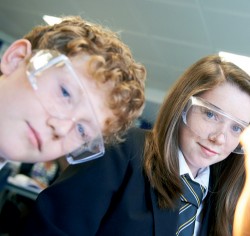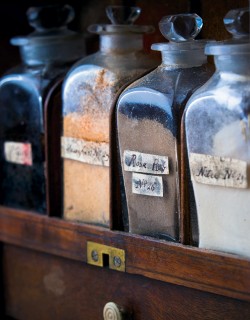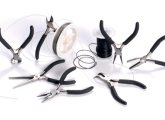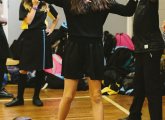Today you will…
Learn about metals and alloys investigate the properties of light explore redox reactions
The Death Eaters rip through the sky curling around the Millennium Bridge in central London. The bridge creaks and moans under the strain, oscillating violently until with a great crack the cables supporting the suspension footbridge snap and recoil. The bridge plummets into the Thames as the cables fly around violently.
How much of this is science and how much is magic? It is interesting that the filmmakers chose this bridge, which had a history of swaying from side to side as people walked across it. Can we explain the Death Eaters’ feat using science not magic? What about making things disappear or evaporate in a flash of light? Is there a potion that can conjure fire without needing matches?
In this skills based lesson pupils will be able to make their own hypotheses and investigate practical scenarios in a range of different contexts. They will learn about metals and alloys and how vibrations alone can cause a solid metal structure to break. The properties of light are investigated and students will learn how the refractive index of a substance can determine whether it can become invisible. Finally, your class will be immersed in the world of chemical potions with redox reactions, creating spectacular light shows and obtaining pure metals like silver.
Starter activity
Bridge Collapse
Students will most likely be familiar with the opening film sequence of Harry Potter and the Half Blood Prince, but will be fascinated by the real life equivalents (Additional Resources 1). The Millennium Bridge, which opened in London in 2000, and the Takoma Narrows Bridge in the USA are very visual examples of the effect of vibrations on large, otherwise stable, structures (AR 2).
The idea of a natural resonant frequency can be modelled in the classroom with a simple pendulum. Students can make their own pendulums with different masses of bob and lengths of string in order to investigate the time period (AR 3). When the pendulum swings at its resonant frequency you will get the maximum swing (amplitude). Extend students by asking them how this scientific knowledge could have helped the Death Eaters plan their flight to collapse the Millennium Bridge.
Main activities

1. Designer metals
The Tacoma Narrows Bridge and the Millennium Bridge are both made of alloys. Alloying metals can substantially affect their properties and the amount of carbon in steel has a profound effect on the tensile strength and hardness of the material.
Pupils can model the process of customising an alloy for a particular purpose in a simple but fascinating experiment using plasticine and coarse sand (AR 4). In this experiment students investigate how easy it is to pull a piece of plasticine until it snaps. The plasticine models the pure metal (iron) and the sand models the carbon added to the steel alloy. A greater quantity of sand mixed with the plasticine is equivalent to a higher carbon steel. When the two broken halves are placed together the permanent increase in length can be measured. Plotting a graph will show that this is related to the amount of sand added.
To stretch and challenge pupils you could ask them to examine the point of fracture on each of their plasticine samples. The surface of their plasticine ‘alloy’ will show the characteristic dimpled structure of a metallic ductile failure and is more pronounced at greater percentages of sand.

2. A disappearing act
Harry Potter has an invisibility cloak; but can science make things really disappear? If we consider how we see transparent glass objects it is because they reflect some of the light that shines on them and refract the light that shines through them. If you eliminate reflection from and refraction by a glass object, you could theoretically make that object disappear.
But can we do it in practice? If a transparent object is surrounded by another material that has the same refractive index, then the speed of light will not change as it enters the object. No reflection and no refraction will take place, and the object will be invisible. This can be demonstrated in the lab. by Pyrex glass and vegetable oil (AR 5). Students can observe a Pyrex test tube in a measuring cylinder completely disappear when oil is poured into the measuring cylinder. They can also watch a Pyrex pipette in a beaker of oil disappear as the oil is sucked into it, and see how difficult it is to stir a beaker of oil with glass rod without being able to see it!
If students are given the refractive index of oil they can use Snell’s law with a variety of plastic and glass blocks to see which could be made to disappear most effectively (AR 6). Conversely they could investigate the best ‘cloak of invisibility’ for a transparent object by using the real and apparent depth method (AR 7) for a range of oils and liquids.

3. Potions lesson
Mixtures of chemicals can create violent and beautiful reactions. One of the most spectacular potions experiments is underwater lightning (AR 8). This demonstration involves placing 3g of potassium chlorate in a goblet and covering it with a 3cm layer of distilled water. A piece of white phosphorus is added (0.2-0.3g). When concentrated sulphuric acid is added drop by drop, close to the piece of phosphorus, lightning flashes are observed. The experiment is especially exciting when the reaction is performed in an almost dark room!
While you have the lights down low, use this next demonstration to create a goblet of fire. Dissolve 1g of boric acid in 25 cm3 of methanol. Transfer the mixture into your ‘goblet’ (glass or crystal has the most stunning effect.) Light the mixture with a spill and watch the stunning cool green flames dancing in the crystal glass.
Finally in a twist on the classic coke and Mentos experiment use tonic water with the sugary mints. The quinine creates a glowing water fountain visible by UV black light.
Home learning
• In this homework students will investigate uses for ‘Smart Alloys’ such as nitinol (AR 10). Tell students that they work for Specciwear, a high street optician. The company’s directors want a presentation on Smart Alloys and the benefit of using them in their products. Students should discover that these alloys ‘remember their shape’ and return to it after being deformed, making them particularly good for glasses and braces.
Summary
Metal displacement reactions are ideal for students to carry out their own ‘potions’ experiments (AR 9). An example is the displacement of copper from copper sulphate by zinc powder, which gives out a measurable amount of energy and produces visible pink copper metal.
Please follow CLEAPPS guide for safe practice and carry out a risk assessment when demonstrating or conducting any of these practicals in your school laboratory.
Info Bar
Additional resources
1. Video of the vibrations of the millennium bridge along with narrative – http://tinyurl.com/33xeyle
2. Video of the collapse of the tacoma narrows bridge along with narrative – http://tinyurl.com/2ca5mh
3. Simulation of the motion of a pendulum – http://tinyurl.com/yldbk27
4. University of Oxford, department of materials, outreach materials – http://tinyurl.com/c7sgvhm
5. Disappearing glass rods – http://tinyurl.com/cuykfup
6. Determining the refractive index of a solid – http://tinyurl.com/d94re3v
7. Determining the refractive index of a liquid – http://tinyurl.com/cmahj4h
8. Roesky,H.W. “spectacular chemical experiments” Wiley-VCH, 2007, page 23
9. Examples of different metal displacement reactions as a class practical – http://tinyurl.com/bljb8jc
10. Smart alloys – http://tinyurl.com/bw6fqvc
Rich pickings
arkive.org is the ultimate free multimedia guide to the world’s animals and plants with resources covering key secondary science topics such as natural selection, adaptation, endangered species, classification and evolution (www.arkive.org/ts).
Stretch them further
A wide range of skills vital to how science works can be developed with the activities described in this lesson. there are many opportunities for students to make and test a formal hypothesis. to test their hypothesis they must chose a dependent variable, independent variable and controlled variables and carry out an experiment according to their chosen method. all students should be able to provide some analysis relating their hypothesis to the outcome, often with the aid of a graph.
About the expert
Dr Joanna L. Rhodes M.Chem, D.Phil, MRSC is a teacher of science at Shelley College, Huddersfield.









